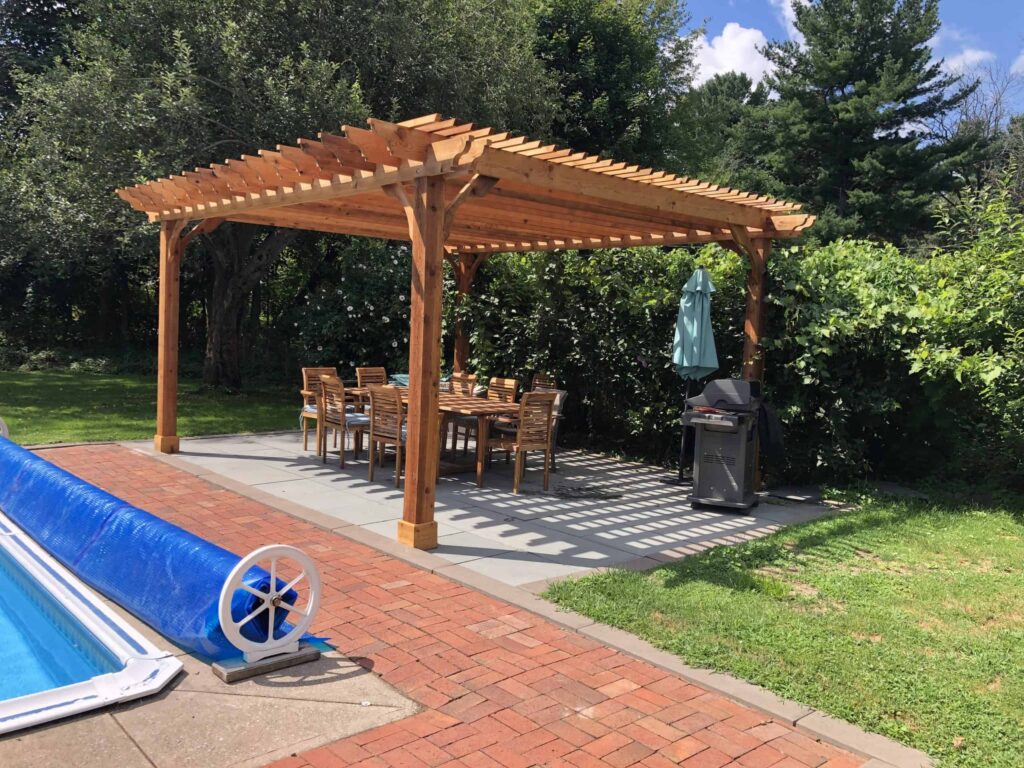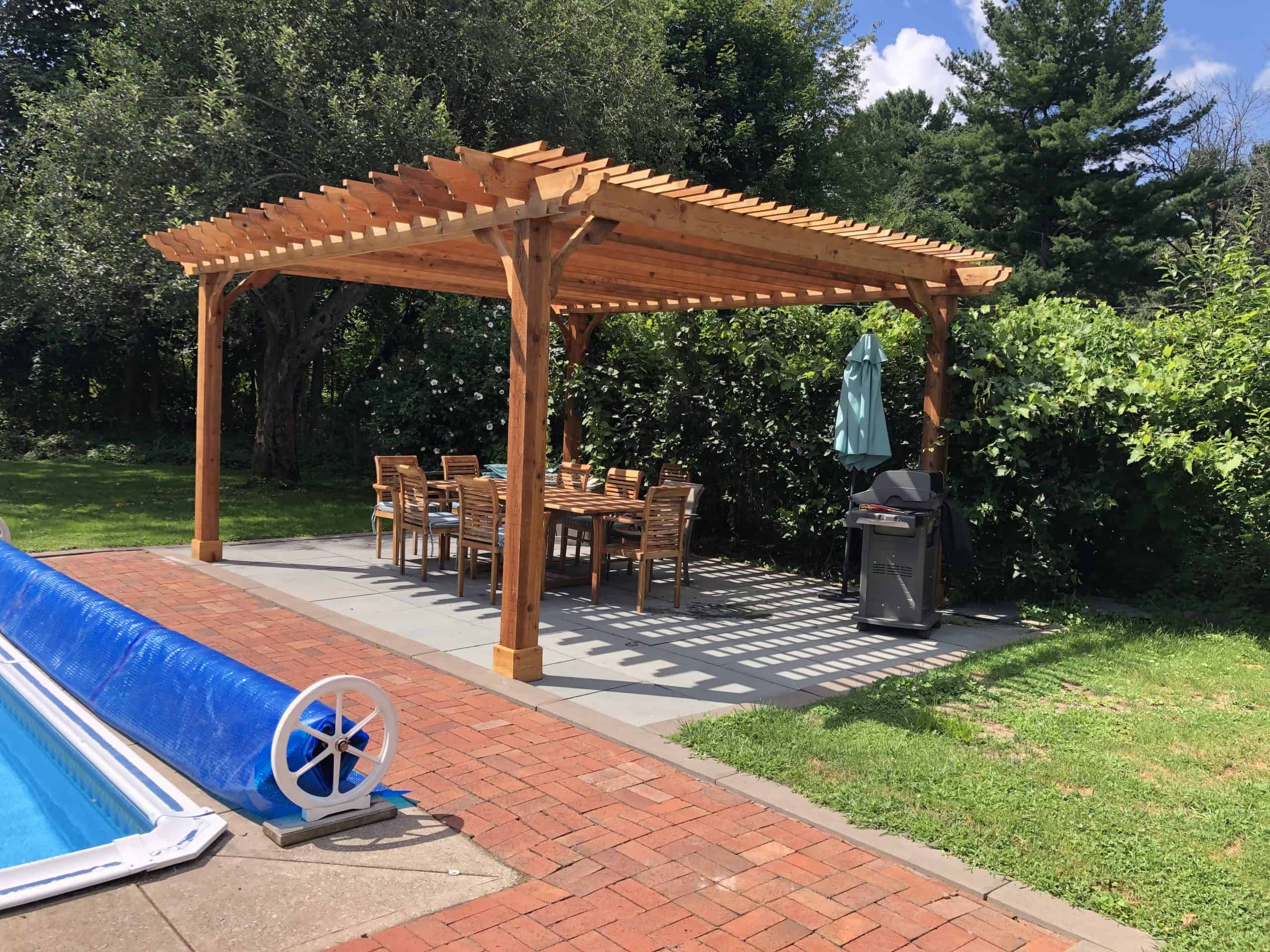
Keep Your Pergola Standing: Securing Your Outdoor Oasis
A pergola can transform a backyard into a sanctuary, a place for relaxation, entertainment, and enjoying the outdoors. However, this idyllic vision can quickly crumble if the pergola isn’t properly anchored. Wind, weather, and the simple passage of time can take their toll, potentially leading to structural instability and even collapse. This comprehensive guide delves into the crucial topic of anchoring your pergola, ensuring its longevity, safety, and aesthetic appeal.
The importance of proper anchoring cannot be overstated. A well-anchored pergola weathers storms, resists shifting soil, and provides a secure structure for climbing plants, overhead lighting, and other decorative elements. Conversely, a poorly anchored pergola is vulnerable to damage, posing a safety hazard to anyone who uses it. This guide will explore the various anchoring methods, materials, and best practices to help you keep your pergola standing strong for years to come.
Understanding the Threats: Why Anchoring Matters
Before diving into the specifics of anchoring, it’s crucial to understand the forces at play that can compromise a pergola’s stability. Wind is perhaps the most significant threat. The sails and open structure of a pergola create a large surface area that catches wind, exerting considerable pressure. High winds can lift, shift, or even topple an unanchored pergola. Furthermore, the location of your pergola plays a significant role. Pergolas in exposed areas, such as near the coast or on a hilltop, are particularly vulnerable to wind damage.
Another factor is the soil. Soil conditions vary widely, ranging from compacted clay to loose sand. The type of soil directly impacts the effectiveness of different anchoring methods. For example, anchoring a pergola in sandy soil requires a different approach than anchoring it in solid rock. Over time, soil can settle, erode, or shift, potentially destabilizing the pergola’s posts. Seasonal changes, such as freezing and thawing, can also contribute to soil movement.
The weight of the pergola itself, as well as any added elements such as climbing plants, hanging lights, or shade cloth, also contributes to the forces acting upon the structure. A heavier pergola requires more robust anchoring to withstand these loads. Therefore, when planning your pergola, consider its size, materials, and intended use to determine the appropriate anchoring strategy.
Choosing the Right Anchoring Method: A Guide to Options
Several anchoring methods are available, each with its own advantages and disadvantages. The best choice depends on factors such as the pergola’s size and design, the soil conditions, local building codes, and your personal preferences.
Concrete Footings: The Gold Standard
Concrete footings are generally considered the most robust and reliable anchoring method. This involves digging holes below the frost line (the depth to which the ground freezes in your region) and pouring concrete footings. The pergola posts are then either embedded directly into the wet concrete or secured to the concrete using metal post anchors. Concrete footings provide excellent stability and resistance to wind and soil movement. However, this method is more labor-intensive and requires more planning and expertise.
When using concrete footings, it’s essential to ensure the concrete mix is appropriate for outdoor use and that the footings are properly sized to support the pergola’s weight and withstand wind loads. Consulting with a local building inspector or a structural engineer is highly recommended to ensure compliance with building codes and to determine the appropriate footing size and depth for your specific situation.
Post Anchors: A Versatile Solution
Post anchors, also known as post bases, are metal brackets that secure the pergola posts to a concrete surface, such as a patio or deck, or directly to the ground. They come in various designs, including surface-mount anchors, which bolt directly to a concrete surface, and embedded anchors, which are set into wet concrete. Post anchors offer a more convenient and less labor-intensive alternative to concrete footings, especially if you’re building your pergola on an existing concrete surface.
When selecting post anchors, choose anchors specifically designed for outdoor use and rated for the anticipated wind loads. The size and type of anchor should be appropriate for the size and weight of the pergola posts. Ensure that the anchors are securely fastened to the concrete surface or embedded correctly in the concrete footings. Regular inspections of the post anchors are essential to ensure they remain secure and free from corrosion.
Ground Stakes: For Temporary or Lightweight Pergolas
Ground stakes, often made of steel, are driven into the ground to provide a temporary or less robust anchoring solution. They are typically used for lightweight pergolas or for situations where a permanent anchoring method is not feasible. Ground stakes are less reliable than concrete footings or post anchors, especially in areas with high winds or unstable soil. They are more susceptible to being pulled out of the ground.
If you choose to use ground stakes, select stakes specifically designed for pergola anchoring and ensure they are driven deep enough into the ground to provide adequate resistance. Consider using multiple stakes per post and cross-bracing the stakes for added stability. Ground stakes are a good option for temporary structures or for locations where you can’t dig or pour concrete. However, always prioritize safety and monitor the pergola’s stability regularly.
Material Matters: Selecting the Right Components
The materials you choose for your pergola’s anchoring system are critical to its longevity and performance. Opting for high-quality, durable materials will ensure your pergola remains secure and withstands the elements. Consider these factors:
- Concrete: Use a concrete mix specifically designed for outdoor use, with a compressive strength appropriate for your climate and soil conditions. Consult with a local building supply store for recommendations.
- Metal Anchors: Choose galvanized steel or stainless steel anchors to resist corrosion. Ensure the anchors are rated for the anticipated wind loads and are compatible with the size and type of your pergola posts.
- Fasteners: Use exterior-grade screws, bolts, and other fasteners made of galvanized steel or stainless steel to prevent rust and corrosion.
Avoid using inferior materials, as they can degrade over time, compromising the pergola’s stability and safety. It’s always best to invest in quality materials to ensure your pergola stands the test of time.
Step-by-Step: How to Anchor Your Pergola
The specific steps for anchoring your pergola will vary depending on the chosen method. However, some general guidelines apply.
Concrete Footings
- Plan: Determine the location of the pergola posts and mark the spots for the footings. Consult with a local building inspector to determine the required footing depth and size.
- Dig: Dig holes to the required depth and diameter for the footings. Ensure the holes are below the frost line.
- Pour Concrete: Mix the concrete according to the manufacturer’s instructions and pour it into the holes.
- Set Posts or Anchors: If embedding posts, insert them into the wet concrete, ensuring they are plumb (perfectly vertical). If using post anchors, set them in the wet concrete according to the manufacturer’s instructions.
- Cure: Allow the concrete to cure completely according to the manufacturer’s instructions before proceeding with the pergola construction.
Post Anchors
- Prepare the Surface: Ensure the concrete surface is clean and level.
- Position the Anchors: Position the post anchors at the designated locations.
- Fasten the Anchors: Secure the anchors to the concrete surface using the appropriate fasteners (usually concrete anchors).
- Attach Posts: Place the pergola posts into the post anchors and secure them with screws or bolts.
Ground Stakes
- Position Stakes: Drive the ground stakes into the ground at an angle, ensuring they are firmly embedded.
- Attach Posts: Secure the pergola posts to the ground stakes using screws, bolts, or other appropriate fasteners.
- Check for Stability: Regularly check the stability of the pergola and tighten the connections as needed.
Always follow the manufacturer’s instructions for the specific anchoring method you choose. If you’re unsure about any aspect of the process, consult with a professional contractor or structural engineer.
Maintenance and Inspection: Keeping Your Pergola Secure
Regular maintenance and inspections are essential to keep your pergola securely anchored and in good condition. Here are some tips:
- Inspect Regularly: Inspect the anchoring system at least twice a year, and after any severe weather events.
- Check for Corrosion: Look for signs of rust or corrosion on metal anchors and fasteners. Replace any corroded components promptly.
- Tighten Fasteners: Tighten any loose screws, bolts, or other fasteners.
- Check for Soil Movement: Look for signs of soil erosion or movement around the pergola posts.
- Address Problems Promptly: If you notice any problems, such as loose anchors or shifting posts, address them immediately.
- Clean the Area: Keep the area around the pergola free of debris and vegetation that could interfere with the anchoring system.
By following these maintenance tips, you can ensure your pergola remains secure and enjoys a long lifespan. Remember that a well-maintained pergola is a safe and enjoyable outdoor space.
Local Building Codes and Permits: Navigating the Regulations
Before beginning any anchoring project, it’s crucial to familiarize yourself with local building codes and obtain any necessary permits. Building codes vary by location and may specify requirements for pergola construction, including anchoring methods, footing size, and wind load resistance. Ignoring these regulations can lead to fines, delays, and even the requirement to dismantle your pergola.
Contact your local building department to inquire about the specific requirements for pergolas in your area. They can provide information on necessary permits, inspections, and any other relevant regulations. A permit is usually required to ensure your pergola meets safety standards. They can also offer guidance on the most appropriate anchoring methods for your location. Compliance with local building codes is not just a legal requirement; it’s also a matter of safety and ensures the structural integrity of your pergola.
Conclusion: A Secure Pergola for Lasting Enjoyment
Anchoring your pergola is a critical step in ensuring its stability, safety, and longevity. By understanding the forces at play, choosing the right anchoring method, using high-quality materials, and following best practices for installation and maintenance, you can keep your pergola standing strong and enjoy your outdoor oasis for years to come. Proper anchoring protects your investment and provides a safe and enjoyable space for relaxation and entertainment. Investing in a well-anchored pergola is an investment in your home and your lifestyle.
Remember to prioritize safety and consult with professionals when necessary. Don’t hesitate to seek expert advice from a contractor or structural engineer if you have any questions or concerns. With the right approach, you can keep your pergola standing and create a beautiful and secure outdoor space that you and your family can enjoy for years to come. This guide provides the knowledge to help you with anchoring your pergola.
[See also: Related Article Titles]


